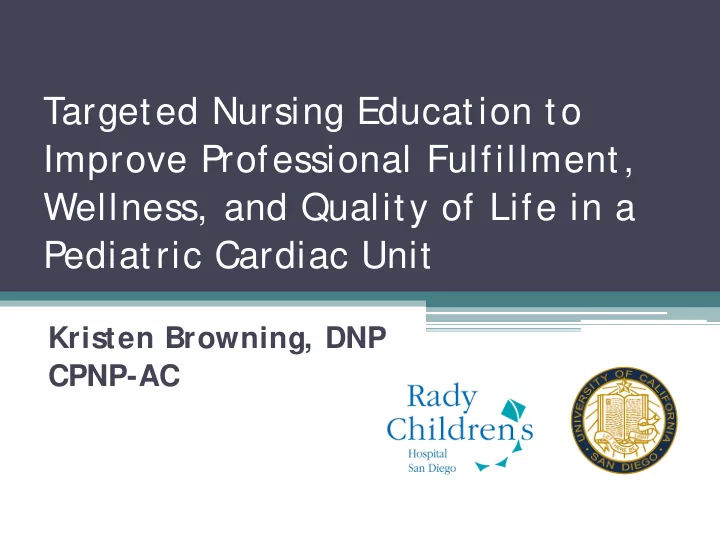

Targeted Nursing Education to Improve Professional Fulfillment, Wellness, and Quality of Life in a Pediatric Cardiac Unit Kristen Browning, DNP , CPNP-AC
All Collaborators Have No Relevant Disclosures to Report
Background • “Burnout is a syndrome of emotional exhaustion, depersonalization and reduced personal accomplishment that can occur among individuals who do ‘people work’ of some kind” (Maslach & Jackson, 1986, p. 99). • “Burnout is a psychological syndrome that occurs in response to chronic emotional and interpersonal stressors at work. It can lead to emotional instability, difficulties to commit, a feeling of failure, and an urge to leave one’s job” (Merlani et al., 2011, p. 1140).
Background • “In pediatric practice, pediatric intensive care units are environments with high occupational stress. The highly technological work environment, the demands of aggressive procedures and the uncertainty inherent in the prognoses result in high psychological pressure for professionals” (Passos dos Santos, Garros, Carnevale, 2018, p. 226). • “Moral distress in an emotional and psychological response to morally challenging dilemmas. Moral distress is experienced frequently by nurses in the intensive care unit and can result in emotional anguish, work dissatisfaction, poor patient outcomes, and high levels of nurse turnover” (Chiafery, Hopkins, Norton, Shaw, 2018, p. 217). • “In nursing practice, burnout may be the result of various forms of distress” (Asayesh, Mosavi, Abdi, Masoud, Jodaki, 2018, p. 1)
Acute Cardiac Unit Rady Children’s Hospital S an Diego
N
Aims • Implement a targeted nursing led educational program to review challenging patient cases in the ACU with the nursing staff • Evaluate prevalence of nursing burnout in the ACU before and after implementation of this program
Methods • Creation of structured educational conference • Development of electronic survey instrument • Pre- and Post- Implementation Assessment • Conference refinement/ program evaluation Survey Survey Conference Conference Conference Program Evaluation/ Conference Conference Conference Refinement 1 Mo 1 Mo 1 Mo 1 Mo 1 Mo 1 Mo
Review patient’s Review of patient’s Introduction of clinical course, any cardiac anatomy patient case, interventions or and physiology, Conference reason patient surgeries received, especially if selected for review and any complex complications Thought process Discuss any behind provider Additional input decisions that the from medical confounding social aspects of the bedside nursing and/or surgical Structure team may not be team case aware of Open forum Closing discussion: clinical Any ethical statements, course, social concerns raised by lessons learned situation, the case from the case decisions made, review and complications
Conclusions • Developed a novel targeted, nursing-led educational program • To improve communication, understanding of complex patients, and reduce burnout and moral distress among bedside nurses in a dedicated cardiac unit • Next steps include analysis of interval change in nursing burnout and distress, iterative program improvement, & implementation in other programs
References Asayesh, H., Mosavi, M., Abdi, M., Masoud, P. M., Jodaki, K. (2018). The relationship between futile care perception and moral distress among intensive care unit nurses. Journal of Medical Ethics and History of Medicine, 11 (2). Atashzadeh-Shoorideh, F., Ashktorab, T., Yaghmaei, F., Majd, H. A. (2015). Relationship between ICU nurses’ moral distress with burnout and anticipated turnover. Nursing Ethics, 22 (1), 64-76. Chiafery, M. C., Hopkins, P., Norton, S. A., & Shaw, M. H. (2018). Nursing ethics huddles to decrease moral distress among nurses in the intensive care unit. Journal of Clinical Ethics, 29 ( 3), 217-226. Ghazaleh, H., Atashzadeh-Shoorideh, F., Ashktorab, T., Mohtashami, J. (2019). Relationship between perceived organizational justice and moral distress in intensive care unit nurses. Nursing Ethics, 26 (2), 460-470. Henrich, N. J., Dodek, P. M., Gladstone, E., Alden, L., Keenan, S. P., Reynolds, S., Rodney, P. (2017). Consequences of moral distress in the intensive care unit: A qualitative study. Am erican Journal of Critical Care, 26 (4), e48-e57. Johnson-Coyle, L., Opgenorth, D., Bellows, M., Dhaliwal, J., Richardson-Carr, S., Bagshaw, S. M. (2016). Moral distress and burnout among cardiovascular surgery intensive care unit healthcare professionals: a prospective cross-sectional survey. Canadian Journal of Critical Care Nursing, 27 (4), 27-36. Maslach, C., & Jackson, S. (1981). The measurement of experienced burnout. Journal of Occupational Behavior, 2, 99-113. McAndrew, N. S., Leske, J., Schroeter, K. (2018). Moral distress in critical care nursing: the state of the science. Nursing Ethics, 25 (5), 552-570. Merlani, P., Verdon, M., Businger, A., Domenighetti, G., Pargger, H., Ricou, B. (2011). Burnout in the ICU: A multicenter study of factors associated to centers. Am erican Journal of Respiratory and Critical Care Medicine, 184, 1140-1146. Passos dos Santos, R., Garros, D., Carnevale, F. (2018). Difficult decisions in pediatric practice and moral distress in the intensive care unit. The Revista Brasileria de Terapia Intensiva, 30 (2), 226-232. Trotochaud, K., Coleman, J. R., Krawiecki, N., McCracken, C. (2015). Moral distress in pediatric healthcare providers. Journal of Pediatric Nursing, 30, 908- 914.
Thank You! Harjot Bassi, MD Karen Catalano, BSN, CCRN Ami Doshi, MD Amie Ryan, BSN, CCRN Denise Suttner, MD David Werho, MD The Entire Cardiac Team at Rady Children’s Hospital
Questions? Kristen Browning, DNP , CPNP-AC kbrowning@rchsd.org
Recommend
More recommend